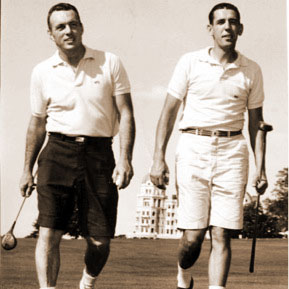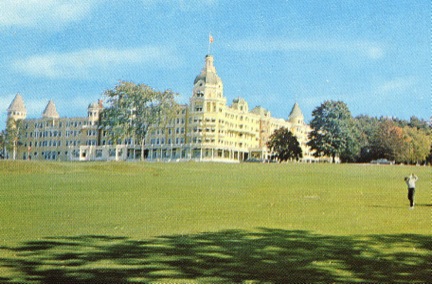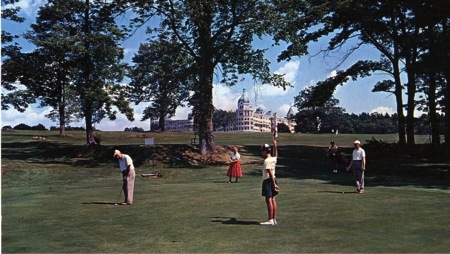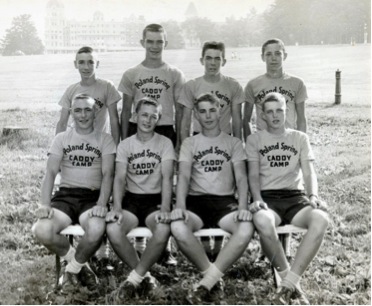
Bob and Chick, on the links with the hotel in the background
Poland Spring Caddy Camp (PSCC)
Caddy Camp: read an essay by KL on Poland Spring Caddy Camp from Downeast Magazine, Spring 2014
(I have finished an account of my eight summers as a kid at the Poland Spring Caddy Camp at the magnificent Poland Spring Hotel in Maine – and am in the process of trying to get it into print. Here’s a summary of the book. kl)
Caddy Camp
Of Boys, Men, Golf, and War
My Caddy Camp story is essentially about golf and boys. It’s also about masculinity, class, adolescence, Maine, sports, prejudice, war, sex, competition, and life in America at the cusp of new things, between the ‘50s’ clichés of a complacent and well-ordered America, before Vietnam, before the Women’s Movement heated up, before Malcolm X and the Black Panthers, before foreign cars, a time when things appeared to make sense, even if they weren’t fair – and the late ‘60s and ‘70s when nothing made sense and everything was turned upside down. Even if the Poland Spring Hotel had been able to survive that era, like some few others of its type and vintage in New England – the Samoset in Rockland, the Colony in Kennebunkport, and the Mount Washington Inn in New Hampshire, the Caddy Camp at Poland Spring would not have survived. The motorized golf cart would have killed it. The handwriting was on the wall my last two years there, when we began to let golfers in carts go out without a caddy. Before that, everyone who played the beautiful 18 hole course at Poland Spring was required to take a caddy.
The caddy, the teenage boy trying to make a few bucks before his 18th birthday, was already a dying breed by 1965, my last year at Poland Spring Caddy Camp. These days, caddies are mostly men, often good golfers themselves, sometimes young men, the golfers’ helpmates: they know the course and can estimate yardages and suggest the proper club to carry the distance they estimate. They make fifty or a hundred dollars a round. In 1958, my first year at Caddy Camp, we made $2.50 a round, and hoped for a 50 cent tip.
My initial motivation for writing about my eight summers at the Poland Spring Caddy Camp was to get down the stories I have been telling for the past five decades, to acknowledge the profound influence of the experience and to provide a personal record of a unique place and time, full of interesting characters and events. For a long time, I feared and lamented that the Caddy Camp was lost forever, forgotten. The Caddy Camp itself, an old three-story stable, burned down in 1984, nine years after the magnificent Poland Spring House, with its five stories and 325 rooms and dozens of ancillary buildings on its 200 acres, went up in flames in a fire of suspicious origin. No record whatever of the Caddy Camp remained. I grieved the lost boys of Caddy Camp. And what a loss: all those boys with all that energy – if we could have tapped it and stored it, we could have lit the hotel for the whole summer and saved on electricity.
The Poland Spring Caddy Camp dated back to 1921. It was affiliated at the outset with the South End Settlement House in Boston, a ten-week summer work experience, closely supervised, for poor or troubled boys. In my years there, 1958-65, the Camp had lost that exclusive relationship, but was still a rugged environment, not in the least a “fun camp.” As caddies, we always hustled, gave a good account: we did it right. We knew as a group we were the best caddies in the world. The Camp was directed by two men the years I was there, Bob Hatch and Chick Leahey, athletic coaches at Bates College, where my father also worked: Bob coached football, Chick baseball. Bob had been a football star at Boston University; Chick had played baseball professionally in the Yankee organization. Both had served in the Marines in World War II. Bob and Chick were universally admired by the boys, even those who hated the camp. They represented an ideal of manhood to us, at a time in our lives when we were searching for role models.
My own kids, I have four, know Caddy Camp as a mythical place of great hardship and glory, a place I would conjure whenever I scolded them for their lassitude or laziness. They rolled their eyes and said, “I know, Dad, when you were our age, you carried two enormous golf bags around an 18 hole golf course on a scorching hot summer day – not once but twice!” My younger son, Peter, responds to my threats now with, “What are you going to do, Dad, send me to Caddy Camp?” I’d like to.
I don’t know if Caddy Camp was a bizarre and inhumane place, sort of a “Lord of the Flies Meets Caddyshack”– or merely the setting for a lot of robust adolescent activity, fun. Probably both. I do know it reflected the values of its era. There was a frank dedication to the notions of masculinity of the time. Everybody was subject to pranks, hazing, kidding, and abuse, even the strongest and most competent caddies. Competition was everything at Caddy Camp. The 52 boys in camp were divided into four teams of 13, named after Indian tribes. Every night, after dinner, an athletic competition of some kind was held among the teams; a team earned points for how well they cleaned the camp in the mornings when it was their turn; a bad caddy performance on the golf course would result in a deduction of team points. At the end of August, one team emerged as the Champs, winner of a fierce summer-long, all-encompassing competition.
The undercurrent, unstated, was that each generation would have its war; men would fight it and places like Caddy Camp were training grounds. The boys who were the butt of jokes would learn to “take it,” develop thick skin, toughen up, so that disappointment or hardship later on would be easier to handle or avoid. But then our war was different from Bob’s and Chick’s. Few of us raced to enlist to fight in Southeast Asia when our turn came. My close friend from Caddy Camp, Richard Buzzell, died there in a helicopter crash. Al Schofield, a caddy and counselor with me, was also killed in Vietnam, at 21, just four years after his last summer at Caddy Camp. I suspect there are others from PSCC whose names are on the Wall in Washington.
The only black camper, Jimmy Taylor, enlisted in the Marines before he got drafted, and served a year in combat, stationed in DaNang, near the DMZ. For Bob Spear, Caddymaster with me in 1963, the memory of a beautiful summer day on the golf course, carrying doubles for two good golfers, provided relief on hot and scary nights in the field in Vietnam. Wayne Chasson, Best Camper in 1964, flew helicopters in Vietnam, and then 35 years later, flew helicopters in Iraq. Caddy Camp with its emphasis on physical bravery, hard work, and team spirit made us all warriors of sorts, but hardly prepared us for the complexity of our little war. Paul Stetson, Captain of the Apaches in 1962, suffered a head injury training as a Marine in California. When he came to, he was asked a series of questions, one of which was, “where did you go to Boot Camp?” He answered, “Poland Spring.”
So “Caddy Camp” is a memoir of my youth, reflections of my eight summers, from age 13 to age 20, from boy to man, at a unique and dynamic place, a work camp at a hotel in the last gasp of the resort movement in the Northeast. It is a descriptive, highly anecdotal, nostalgic text. My hope is that it is interesting and entertaining, and can lay modest claim to cultural history. At its most basic level, it’s about carrying a golf bag and the boys who did it and the men who took care of them for two and a half months in the summer, occasionally crudely. I was both. “Caddy Camp” is about my initiation into manhood in a small self-contained world, this institution within an institution, keenly aware of its own history and purpose, a microcosm of its time in many ways, for me both a lifetime and a moment in time.
Table of Contents
1. Introduction: Not a Fun Camp!
2. Details, Duties, Inspections, and Cold Showers: Camp Routine
3. Opulence and Entertainment: The Poland Spring House
4. Replacing Divots: The Best Caddies in America
5. “Karl with-a-K”: Caddymaster
6. Bob’nChick – Parris Island-North
7. Boston’s Pete Carroll: “The Most Significant Thing in my Life”
8. Saul, Tudi, and “the Children of Abraham”
9. Bombardment, Boxing, King-of-the-Hill: Teams, Games, and Competition
10. Smacker, Mac, Baby Huey, and Jimmy Taylor
11. Night Caddying, Rookie Night, Campbell’s Landing
12. Playing Lessons: Bob Card, Golf Pro
13. Lessons from Mimi: Summer Romance
14. Abbott & Costello Go Camping: Gary Visits Caddy Camp
15. The Picture: Captains and Lieutenants – Boys to Men
16. Vietnam: The Monster in the Closet
17. The Handwriting on the Wall: The Fire
18. The Reunion
19. Afterword: America of the Golf Cart/The Lost Boys of Caddy Camp
Appendix:
A. Rules, Regulations and Suggestions for the 1958 Poland Spring Caddy Camp
B. General Staff Instructions
C. General Guide for Officer of the Day
D. “Thanks for the Memories”: Mac’s Notes, February 2012
E. “Number One,” Phil Niddrie
F. Bob Spears Guest of Honor Speech, Marine Corps Birthday Ball, Quantico, 11/2011
Caddies work the 12th green
Captains and Lieutenants, 1960
Caddy Camp Staff, 1964



